The Formula 1 Safety Car is a crucial part of every race, ensuring the safety of drivers, track workers, and spectators. It comes into action when dangerous situations arise, such as accidents or unsafe track conditions. Its job is not only to protect, but also to keep the race flowing smoothly during challenging moments.
The concept of the Safety Car was introduced in 1973 in Canada, but its first deployment caused a bit of confusion during the race. For the first 20 years, high-performance cars from various manufacturers served as the Safety Car, depending on the track. However, it wasn’t until 1993 that the role was standardized, mainly because the original Safety Car couldn’t keep up with the race pace, as seen in Brazil.
Since the early 2000s, Mercedes-Benz AMG models have taken over the role of the Safety Car, and Bernd Mayländer has been the official driver since 2000. Mayländer has only missed a few races during his time as the Safety Car driver.
It’s also important to note that at the start of the race, and during certain points of the race, the Safety Car is not the first vehicle on track. Instead, it’s the Medical Car, a high-performance five-door Mercedes, which is deployed to help assess and transport any injured individuals if needed.
10) The 1975 Porsche 911 Turbo (930) A Game-Changer in Formula 1 Safety Cars
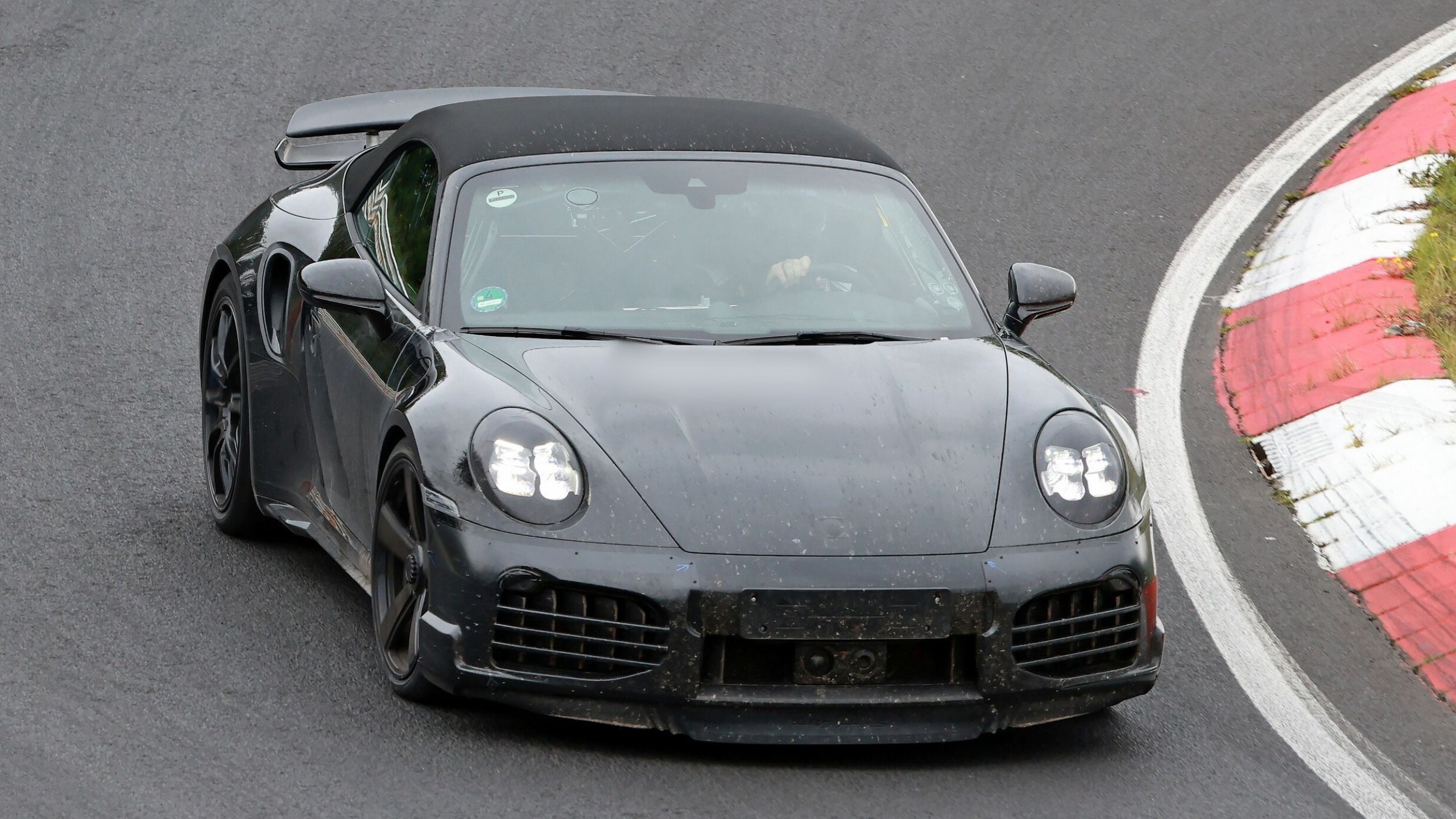
The Porsche 911 Turbo (930), introduced in 1975, was a groundbreaking model that would forever change in high-performance sports cars. With its turbocharged 3.0-liter flat-6 engine, it quickly established itself as one of the fastest and most exciting cars of its time. The 911 Turbo wasn’t just about speed, though—it was also about style, handling, and power, elements that would make it an iconic model in Porsche’s history.
The 930’s engine produced an impressive 256 horsepower and 243 lb-ft of torque, propelling the car from 0 to 60 mph in just 5.2 seconds. That acceleration made it one of the fastest cars of the 1970s. With a 4-speed manual transmission, the driving experience was pure and exhilarating, with every push of the pedal delivering a rush of power.
Porsche also made significant improvements to the 911’s design to accommodate the turbo engine. The bodywork was revised to give the car a wider rear track, allowing for wider tires that offered better grip. The large fixed rear wing became a defining feature of the 930, adding both style and stability at high speeds. These design changes not only improved the car’s performance but also gave the 911 Turbo a unique and aggressive look that set it apart from other sports cars of the era.
In 1976, the Porsche 911 Turbo was selected as the official Formula 1 Safety Car for the Monaco Grand Prix, showcasing its performance and handling capabilities. The 930’s role as a Safety Car was symbolic of its legendary status, as it blended speed with style, proving to be a worthy companion to the high-speed thrills of Formula 1.
The Porsche 911 Turbo is a quintessential sports car that embodies a legacy of performance, engineering excellence, and timeless design. Since its introduction in 1975, the 911 Turbo has evolved through multiple generations, continually redefining the standards of speed, agility, and luxury. Known for its iconic shape and powerful engine, the Turbo variant has established itself as one of the most desirable models within the Porsche lineup.
The first 911 Turbo, known as the 930, debuted in 1975 and featured a distinctive wide body with flared wheel arches and a prominent rear spoiler. Powered by a 3.0-liter turbocharged flat-six engine, it delivered 260 horsepower, allowing it to accelerate from 0 to 60 mph in just over 5 seconds. This was remarkable performance for its time, and the Turbo quickly gained a reputation for its exhilarating driving experience and thrilling acceleration.
One of the most notable aspects of the 911 Turbo is its unique combination of performance and everyday usability. Despite its supercar status, the Turbo offers a comfortable interior with high-quality materials and advanced technology. The cockpit is designed with the driver in mind, featuring intuitive controls and supportive seating, making it suitable for both spirited drives and long-distance journeys.
As the Turbo evolved through subsequent generations, Porsche continued to refine its performance characteristics. The 964 generation, introduced in 1989, marked a significant milestone with the addition of all-wheel drive, enhancing traction and stability.
This was further improved in the 993 generation, which debuted in 1995 and is often regarded as one of the best iterations of the 911 Turbo. The 993 Turbo featured a more powerful 3.6-liter engine producing 400 horsepower, allowing it to achieve a 0 to 60 mph time of just 4 seconds.
The 996 generation, introduced in 1999, brought significant advancements in technology and performance. The 911 Turbo featured a new water-cooled engine, which increased efficiency and reduced emissions.
With a twin-turbocharged 3.6-liter flat-six engine producing 420 horsepower, the 996 Turbo offered breathtaking performance and agility. The model’s aerodynamic design and active aerodynamics contributed to its stability at high speeds, making it a formidable contender on both the street and the track.
The 997 generation, launched in 2005, further refined the 911 Turbo, offering improved handling and enhanced technology. With an upgraded twin-turbocharged engine producing up to 500 horsepower in the Turbo S variant, the 997 Turbo demonstrated Porsche’s commitment to performance excellence. The introduction of the Porsche Doppelkupplung (PDK) transmission allowed for lightning-fast gear shifts, enhancing the driving experience and providing seamless acceleration.
In 2012, the 991 generation of the 911 Turbo was introduced, featuring a more modern design and advanced engineering. The new model retained the essence of the Turbo while incorporating cutting-edge technology, such as active aerodynamics and rear-wheel steering. The 911 Turbo S variant, with its 3.8-liter twin-turbocharged engine producing 560 horsepower, showcased Porsche’s engineering prowess, achieving 0 to 60 mph in just 2.6 seconds—one of the fastest times in its class.
The latest iteration, the 992 generation, continues the Turbo legacy with enhanced performance and technology. The 911 Turbo S features a 3.8-liter twin-turbocharged flat-six engine producing 640 horsepower, further solidifying its position as a leader in the sports car segment. The 992 Turbo S includes advanced driver assistance systems and connectivity features, making it a blend of performance and modern luxury.
Throughout its history, the Porsche 911 Turbo has made a significant impact on automotive culture and motorsport. Its racing pedigree includes successes in various championships, where the Turbo’s speed and handling have proven to be formidable. The model’s success on the track has reinforced its status as a performance icon, inspiring generations of car enthusiasts.
The 911 Turbo’s design has remained consistent over the years, with its signature round headlights, sloping roofline, and rear-engine layout. This iconic silhouette has become synonymous with Porsche, making the 911 instantly recognizable on the road. The attention to detail in both the exterior and interior design reflects Porsche’s commitment to quality and craftsmanship.
Collectors and enthusiasts highly value the 911 Turbo, with vintage models often fetching impressive prices at auctions. The Turbo’s blend of performance, style, and engineering excellence has ensured its desirability among car lovers worldwide. As a result, the 911 Turbo has become a staple in the luxury sports car market, representing the pinnacle of Porsche’s engineering achievements.
In addition to its performance and design, the 911 Turbo has become a cultural icon, appearing in films, television shows, and video games. Its presence in popular culture has contributed to its legendary status, capturing the imagination of enthusiasts and casual fans alike. The Turbo’s association with speed and luxury makes it a symbol of aspiration for many.
Driving a Porsche 911 Turbo is an exhilarating experience, characterized by its precise handling, powerful acceleration, and engaging engine sound. The combination of rear-engine dynamics and all-wheel drive offers exceptional grip and responsiveness, making it a joy to drive on winding roads and racetracks. The Turbo delivers not only performance but also a sense of connection between the driver and the car.
The Porsche 911 Turbo is a remarkable sports car that has stood the test of time. Its evolution over the years showcases Porsche’s dedication to performance, innovation, and luxury. With its rich history, striking design, and exhilarating driving experience, the 911 Turbo remains a benchmark for sports cars, inspiring admiration and respect from enthusiasts around the world. The legacy of the 911 Turbo continues to thrive, ensuring its place as one of the greatest sports cars ever produced.
9) The First Iconic Formula 1 Safety Car 1973 Porsche 914
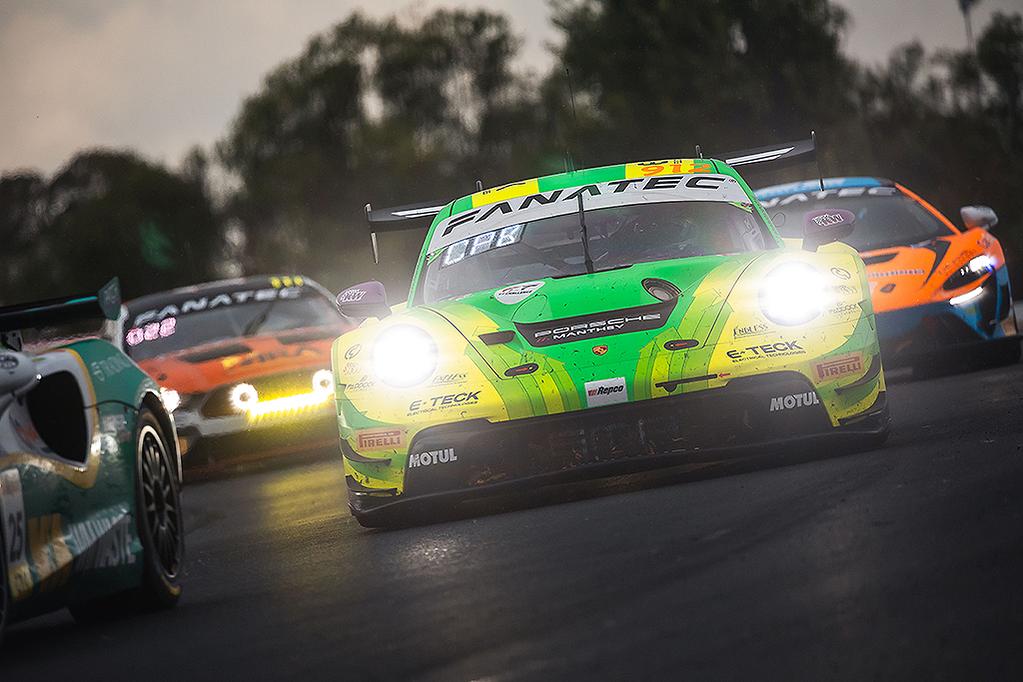
The first-ever official Formula 1 Safety Car made its debut at the 1973 Canadian Grand Prix, held at Mosport Park (now known as Canadian Tire Motorsport Park). This marked a significant moment in the history of Formula 1, where a dedicated vehicle was deployed to ensure safety during the race.
The car used for this important task was a yellow Porsche 914, a product of the collaboration between Porsche and Volkswagen. The 1973 version of the Porsche 914 came with a 1.8-liter VW boxer-4 engine, delivering 95 horsepower and 103 lb-ft of torque. It was equipped with a 5-speed manual transmission, allowing it to go from 0 to 60 mph in about 9.9 seconds. Despite its small size and lightweight design, it was capable of handling the demands of the track.
However, the debut of the Porsche 914 as the Safety Car wasn’t without its issues. During Lap 32 of the race, the yellow Porsche 914 pulled onto the track as the Safety Car, but it failed to pick up the leading cars in the field. This mistake allowed driver Peter Revson to pick up a lap on the rest of the field, and he eventually went on to win the race in a controversial decision.
Despite its rocky start, the 1973 Porsche 914 remains an important part of Formula 1’s history as the first-ever Safety Car, setting the stage for future developments in the role and the use of high-performance vehicles to ensure the safety of drivers.
The Porsche 914 is a unique model in the brand’s storied history, known for its distinctive design and engaging driving experience. Introduced in 1969 and produced until 1976, the 914 represented a collaboration between Porsche and Volkswagen, combining the performance and styling of a sports car with the practicality of a compact roadster. Its innovative engineering and accessible price point contributed to its popularity among enthusiasts and casual drivers alike.
The 914 was designed as a mid-engine sports car, a layout that significantly enhanced its handling and balance. By positioning the engine behind the seats, the 914 achieved a near-perfect weight distribution, resulting in nimble and responsive driving dynamics. This layout was relatively uncommon for cars in its class at the time, making the 914 a standout option for those seeking spirited driving.
The exterior design of the 914 is characterized by its low profile, sleek lines, and distinctive removable targa roof panel. This design allowed for a versatile driving experience, enabling drivers to enjoy open-air motoring while maintaining the structural integrity of a coupe. The bold styling, highlighted by large headlights and a wide stance, gave the 914 an aggressive and sporty appearance that still attracts attention today.
Powering the 914 were a range of flat-four and flat-six engines, depending on the model and trim level. The entry-level 914 featured a 1.7-liter flat-four engine producing around 80 horsepower, which offered adequate performance for a lightweight sports car.
The more powerful 914/6 variant, introduced in 1970, was equipped with a 2.0-liter flat-six engine sourced from the Porsche 911, delivering around 110 horsepower. This configuration allowed the 914/6 to accelerate from 0 to 60 mph in just over 7 seconds, a respectable time for its era.
The interior of the Porsche 914 was designed with a focus on simplicity and functionality. While it lacked some of the luxury features found in more expensive sports cars, the cabin offered a driver-centric layout with clear instrumentation and supportive seating. The minimalist design was practical, providing ample space for passengers and cargo, making it suitable for weekend getaways or daily driving.
One of the most appealing aspects of the 914 was its affordability compared to other Porsche models. This accessibility made it an attractive option for younger drivers and those new to sports cars. The 914 quickly gained a reputation as a fun and engaging vehicle, capable of delivering an exhilarating driving experience without breaking the bank.
As the 914 evolved through its production run, Porsche introduced various improvements and updates. In 1973, the 914 received a significant power boost with the introduction of a new 2.0-liter flat-four engine, which offered 100 horsepower. This upgrade improved performance and made the 914 even more appealing to driving enthusiasts. Despite these enhancements, the model maintained its focus on lightweight construction and agile handling.
The Porsche 914’s motorsport pedigree is noteworthy, with the car competing in various events, including rally racing and SCCA competitions. Its lightweight design and mid-engine layout made it a formidable contender on the track, showcasing its performance capabilities and solidifying its status among sports car enthusiasts.
The production of the 914 came to an end in 1976, but its legacy continues to resonate with collectors and enthusiasts. The car’s unique design, combined with its accessible price and engaging driving dynamics, has led to a resurgence of interest in the model. Today, well-preserved examples of the 914 can command impressive prices at auctions, reflecting its status as a classic sports car.
Restoration and modification have also become popular among enthusiasts, with many choosing to enhance the performance and aesthetics of their 914s. Various aftermarket parts and upgrades are available, allowing owners to personalize their vehicles and tailor them to their specific driving preferences. This vibrant community of 914 enthusiasts ensures that the model remains relevant in the automotive.
The Porsche 914’s cultural impact is evident in its appearances in films, television shows, and automotive events. Its distinctive styling and association with the Porsche brand have made it a favorite among car collectors and enthusiasts. The 914 is often celebrated for its innovative design and engineering, showcasing Porsche’s commitment to performance and quality.
Driving a Porsche 914 is an exhilarating experience characterized by its precise steering and agile handling. The mid-engine layout provides exceptional balance, allowing the car to find corners with confidence. The lightweight construction contributes to its responsiveness, making it a joy to drive on winding roads. The open-top design enhances the driving experience, creating a connection between the driver and the surroundings.
The Porsche 914 is a remarkable sports car that combines innovative engineering with distinctive design. Its mid-engine layout, lightweight construction, and engaging driving dynamics have secured its place in automotive history.
The model’s affordability and accessibility made it a popular choice among enthusiasts, contributing to its enduring appeal. The 914’s legacy continues to thrive, ensuring its status as a beloved classic among Porsche aficionados and sports car lovers alike. Its unique blend of performance, practicality, and style has left an indelible mark on the automotive world.
8) Lamborghini Countach LP500S The Ultimate Safety Car at Monaco
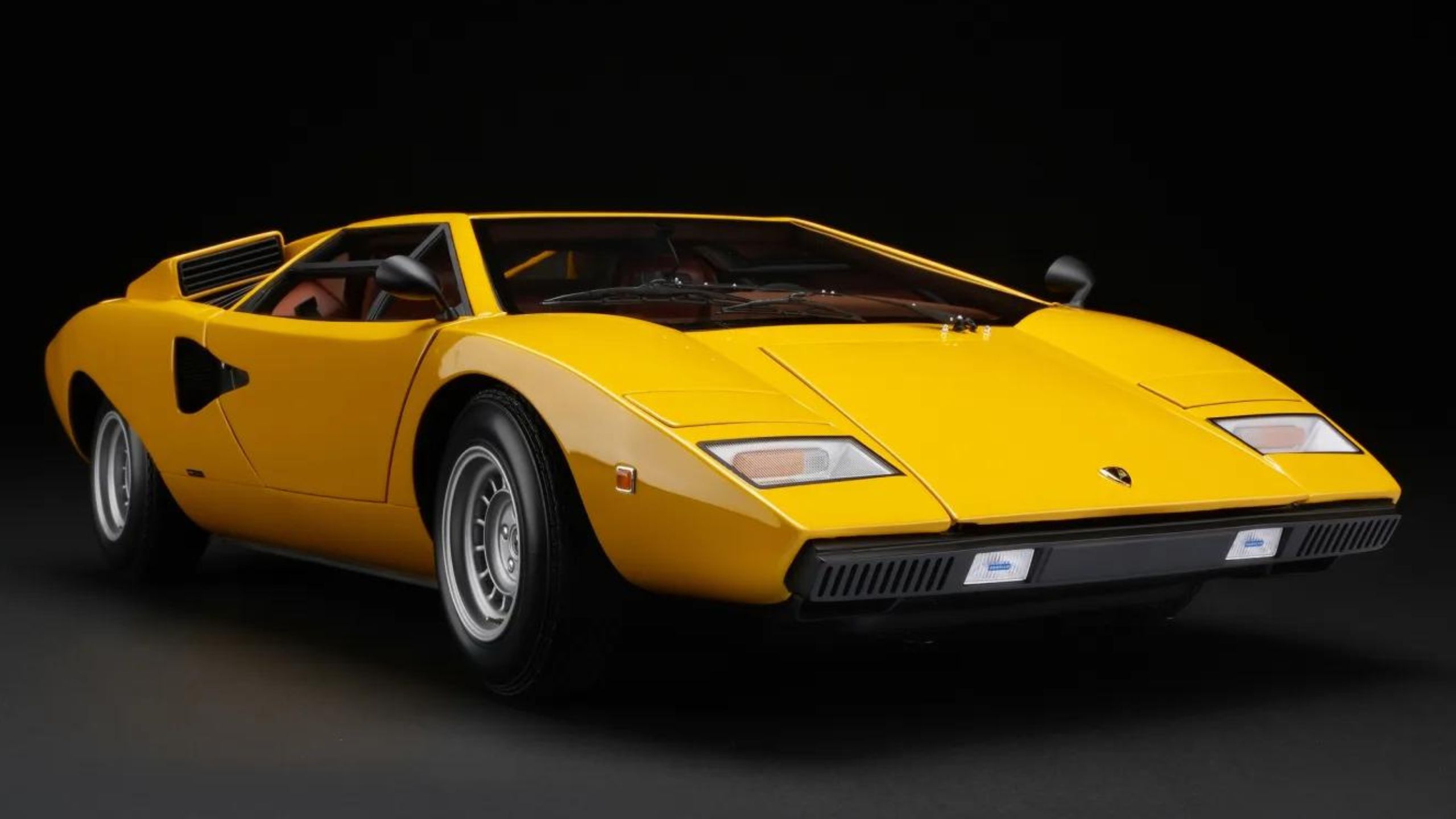
The Lamborghini Countach is a car that defined the exotic sports car genre, and its role as a safety car in the 1981-1983 Monaco Grand Prix was a fitting tribute to its legacy. Introduced in 1974, the Countach was already an icon by the time it was enlisted as the official safety car for the famous Monte Carlo circuit.
Powered by a 4.8-liter V12 engine, the Countach generated 375 horsepower, which allowed it to sprint from 0 to 60 mph in just 5.7 seconds—a remarkable feat in its day. This engine, known for its power and smoothness, would go on to become Lamborghini’s signature setup for years to come. The car’s low, wide stance and sharp lines made it the perfect choice to lead the pack of Formula 1 cars around the narrow, twisting streets of Monaco.
Unlike many modern safety cars, which rely on aerodynamic enhancements and bulky modifications, the Countach was all about raw, unfiltered beauty and performance. Its design was pure Lamborghini: aggressive, sharp, and unmistakable. The car’s sleek body, combined with the powerful V12, made it an ideal companion for the high-octane world of Formula 1.
Despite its stunning looks and high performance, the Countach never needed any extra aerodynamic add-ons that would become synonymous with future supercars. It was simply the right choice for the job in Monaco, where the luxury and wealth of the city are mirrored by the sophistication and power of the cars that drive through it.
The Countach’s presence in Monaco cemented its status as one of the most iconic cars of the 1980s, and it will forever be remembered as a safety car that exuded style, power, and prestige.
The Lamborghini Countach is an iconic supercar that has captured the imagination of automotive enthusiasts since its debut in the early 1970s. Renowned for its futuristic design and high-performance capabilities, the Countach represents a significant milestone in Lamborghini’s history and in the evolution of supercars. It introduced many features that would become hallmarks of the brand, solidifying its reputation for innovation and performance.
Introduced in 1974, the Countach was designed by Marcello Gandini of the Bertone design studio. Its striking appearance featured sharp angles, a low profile, and the signature scissor doors, which opened upward to create a dramatic entrance. The overall design was revolutionary, with a wedge-shaped silhouette that emphasized its aerodynamic prowess and aggressive stance. The Countach’s aesthetic has influenced countless supercars that followed, making it a defining model in automotive design.
Under the hood, the Countach was powered by a series of V12 engines, starting with the 4.0-liter engine in the early models, which produced around 375 horsepower. This was later upgraded to a 4.8-liter engine in the 5000 QV (Quattrovalvole) variant, delivering an impressive 455 horsepower. The power produced by the V12 engine allowed the Countach to accelerate from 0 to 60 mph in just over 5 seconds, a remarkable feat for its time. Its top speed reached around 180 mph, making it one of the fastest cars of the 1980s.
The Countach’s performance was complemented by a lightweight chassis, primarily constructed from aluminum and steel, which enhanced its agility and handling. The car’s mid-engine layout contributed to its exceptional balance, allowing drivers to experience a thrilling driving experience. Coupled with a five-speed manual transmission, the Countach offered a direct connection between the driver and the road, amplifying the sense of speed and excitement.
The interior of the Countach was characterized by its driver-focused design and minimalist approach. While it lacked some of the luxury features found in modern supercars, the cabin was functional and sport-oriented, featuring high-back bucket seats and a straightforward dashboard layout. The emphasis was on performance, with controls positioned for easy access during spirited driving. Despite its utilitarian feel, the interior was well-appointed, reflecting Lamborghini’s commitment to quality.
Throughout its production run, the Countach underwent several updates and improvements. The most notable variants included the LP400, LP400S, and the LP5000 QV. Each version brought enhancements in performance, handling, and comfort, catering to the evolving tastes of supercar enthusiasts. The LP400S, introduced in 1978, featured wider wheel arches and upgraded suspension, providing a sportier appearance and improved handling dynamics.
The Countach’s influence extended beyond the performance cars. It became a cultural icon, frequently appearing in films, television shows, and video games, solidifying its status as a symbol of luxury and speed. Its striking design and performance capabilities made it a favorite among celebrities and affluent car collectors, further elevating its status in popular culture.
Collectors highly prize the Countach, with well-preserved examples fetching significant sums at auctions. The car’s rarity and historical significance contribute to its desirability, making it a sought-after model for enthusiasts and investors alike. Its classic styling and legendary performance ensure that the Countach remains a key part of Lamborghini’s heritage.
Driving a Lamborghini Countach is an unforgettable experience characterized by its raw power and presence on the road. The roar of the V12 engine, coupled with the car’s aggressive styling, creates an exhilarating atmosphere that draws attention wherever it goes. The Countach offers a visceral connection to the driving experience, providing feedback that engages the driver and amplifies the excitement of performance driving.
As the automotive industry evolved, the Countach’s design language and engineering principles influenced the development of future Lamborghini models. The blend of performance, style, and cutting-edge technology established a blueprint that continues to define the brand’s approach to supercars. The legacy of the Countach lives on in modern Lamborghini models, which incorporate elements of its design and engineering philosophy.
In its later years, the Countach faced increasing competition from newer supercars that boasted advanced technology and improved performance. Despite this, the Countach maintained its status as a revered classic, known for its striking design and thrilling performance. The car’s character and legacy continue to resonate with enthusiasts, solidifying its place in automotive history.
The Lamborghini Countach remains an enduring symbol of automotive excellence, representing the pinnacle of performance and design in the supercar segment. Its groundbreaking styling, powerful V12 engine, and exhilarating driving experience have left an indelible mark on the automotive world.
As a cultural icon and a beloved classic, the Countach’s legacy continues to inspire a new generation of car enthusiasts and collectors, ensuring that it remains an integral part of Lamborghini’s storied history. The Countach not only defined an era of supercars but also set the standard for what a high-performance vehicle should aspire to be.
7) Porsche 911 GT2 (993) The Legend that Roared as Formula 1’s Safety Car
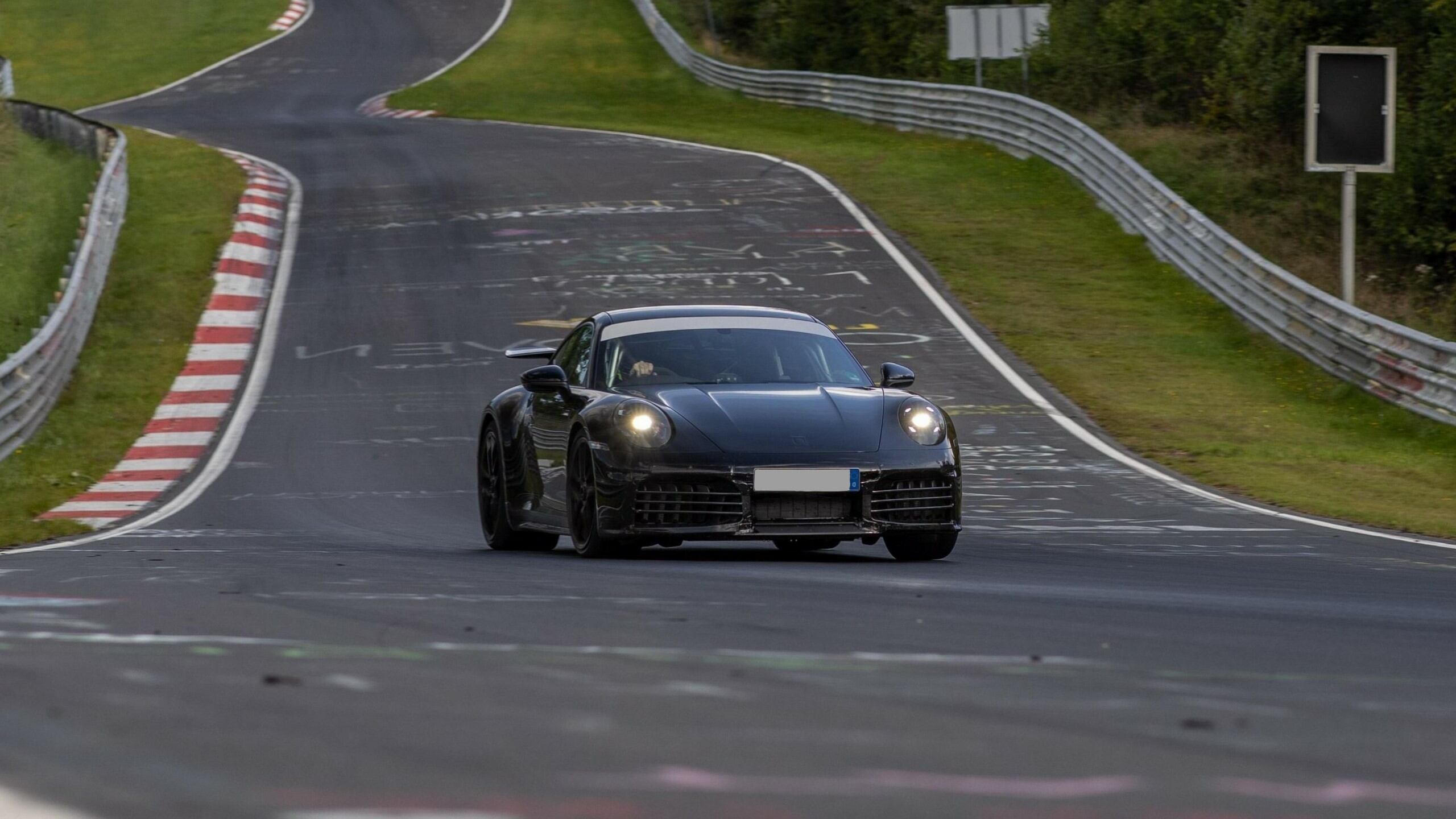
The Porsche 911 GT2 (993), a true icon of performance, played a pivotal role in Formula 1 as the safety car for the 1995 Belgian Grand Prix. This legendary car, produced in a limited run of only 57 units, was a homologation special created for road racing, specifically for the GT2 class. Porsche’s decision to create the GT2 model was driven by the need for a car that could balance sheer power with remarkable handling, and the 911 GT2 delivered on both fronts.
Under the hood of the 1993 Porsche 911 GT2 was a powerful 3.6-liter twin-turbocharged flat-six engine, capable of producing 424 horsepower at 6,000 rpm. With 432 lb-ft of torque, this beast could accelerate from 0 to 60 mph in just 3.9 seconds.
The lightweight design, made possible by removing the all-wheel-drive system from the standard 911 Turbo, allowed the GT2 to achieve astonishing acceleration and handling, while still maintaining everyday comfort. By the end of its production run, the GT2’s output increased to 444 horsepower, solidifying its position as a performance powerhouse.
One of the defining characteristics of the Porsche 911 GT2 was its dynamic sports coupe status. Despite its blistering performance, it was still a car that could comfortably handle daily driving duties, making it a versatile option for enthusiasts. Its success on both the road and the track made it a highly sought-after collector’s item today.
As a safety car during the 1995 Belgian Grand Prix, the Porsche 911 GT2 epitomized the fusion of performance and safety, leading the Formula 1 pack with a powerful roar. Even years after its release, the 911 GT2 remains one of Porsche’s most iconic models, cementing its place in both automotive and Formula 1 history.
The Porsche 911 GT2 is a high-performance variant of the iconic 911 sports car, celebrated for its exhilarating power and track-ready capabilities. Since its inception in the late 1990s, the GT2 has become synonymous with raw performance, delivering an engaging driving experience that embodies the spirit of Porsche. This model showcases the brand’s engineering prowess, combining advanced technology with the distinctive design elements of the 911.
The first generation of the 911 GT2 was introduced in 1995 as part of the 993 series. It featured a twin-turbocharged 3.6-liter flat-six engine, producing an impressive 430 horsepower. This significant power boost over the standard 911 models allowed the GT2 to accelerate from 0 to 60 mph in just over four seconds, showcasing its extraordinary performance capabilities. The GT2’s top speed exceeded 180 mph, making it one of the fastest production cars of its time.
The 911 GT2’s design is a blend of form and function, featuring an aggressive stance that hints at its performance capabilities. The wider body, prominent rear wing, and unique front fascia distinguish it from other 911 variants. The aerodynamic enhancements not only contribute to its striking appearance but also improve downforce, providing stability at high speeds. The design elements reflect Porsche’s commitment to creating cars that are both visually stunning and highly functional.
In terms of handling, the GT2 benefits from Porsche’s advanced engineering, including a rear-wheel-drive layout and an active suspension management system. This setup enhances the car’s agility and responsiveness, allowing drivers to push it to the limit on the track or during spirited drives on winding roads. The GT2’s lightweight construction, achieved through the use of materials such as aluminum and carbon fiber, further enhances its performance, making it a true driver’s car.
The interior of the 911 GT2 is focused on the driving experience, with a layout designed to keep the driver engaged. High-quality materials and supportive sports seats create a comfortable environment, while the straightforward dashboard layout ensures easy access to essential controls. While the GT2 prioritizes performance, it does not compromise on luxury, offering features such as premium audio systems and advanced infotainment options, providing a balance between comfort and sportiness.
Porsche continued to evolve the GT2 with subsequent generations, introducing the 997 GT2 in 2007. This model featured a more powerful 3.6-liter engine, producing 530 horsepower, which further improved performance metrics. The 997 GT2 was equipped with advanced technologies, including a seven-speed dual-clutch transmission (PDK) and enhanced aerodynamics, making it an even more capable track-focused machine.
The GT2’s motorsport pedigree is evident in its success on the race track. The model has participated in various racing events, including the FIA GT Championship and the 24 Hours of Le Mans. Its competitive spirit and engineering excellence have made it a formidable contender, showcasing Porsche’s commitment to motorsport and performance-oriented vehicles. This racing heritage translates into the GT2’s street performance, providing drivers with a taste of track-ready capabilities.
Driving the 911 GT2 is an exhilarating experience marked by the roar of the twin-turbocharged engine and the responsive handling characteristics. The acceleration is breathtaking, pushing the driver back into their seat as the car surges forward. The precise steering and strong braking capabilities allow for confident cornering, making the GT2 a thrilling companion on both the road and the track. Each drive reinforces the car’s reputation as a high-performance machine designed for enthusiasts.
The 991 generation of the GT2, introduced in 2015, continued the legacy of performance and innovation. The GT2 RS variant, launched in 2017, became the most powerful 911 ever produced, boasting a staggering 700 horsepower from its 3.8-liter twin-turbo engine. This version featured extensive weight-saving measures, including lightweight components and a stripped-down interior, prioritizing performance above all. The GT2 RS could accelerate from 0 to 60 mph in just 2.7 seconds, setting new benchmarks for supercars.
The exclusivity of the 911 GT2 adds to its allure, with limited production numbers making it a coveted model among collectors. Its status as a high-performance variant ensures that it retains its value over time, attracting enthusiasts and investors alike. As the automotive evolves, the GT2 continues to be recognized as a benchmark for performance in the sports car segment, blending heritage with cutting-edge technology.
The Porsche 911 GT2 is a testament to the brand’s dedication to performance, innovation, and driver engagement. Its combination of power, handling, and iconic design has established it as a revered model within the 911 lineup and the broader automotive community. The GT2 exemplifies the essence of Porsche, providing a driving experience that is both thrilling and accessible, appealing to a wide range of enthusiasts.
The Porsche 911 GT2 is more than just a high-performance car; it is a celebration of automotive engineering and a symbol of the brand’s legacy. With each iteration, the GT2 has pushed the boundaries of what a sports car can achieve, delivering an unparalleled driving experience that resonates with enthusiasts around the world.
Whether on the road or the racetrack, the GT2 embodies the spirit of performance that has defined Porsche for decades, ensuring its place in the pantheon of legendary supercars. Its blend of raw power, advanced technology, and iconic design continues to grab automotive enthusiasts, making it a true masterpiece of engineering.
6) Ford Escort RS Cosworth A Rally Icon as Formula 1’s Safety Car
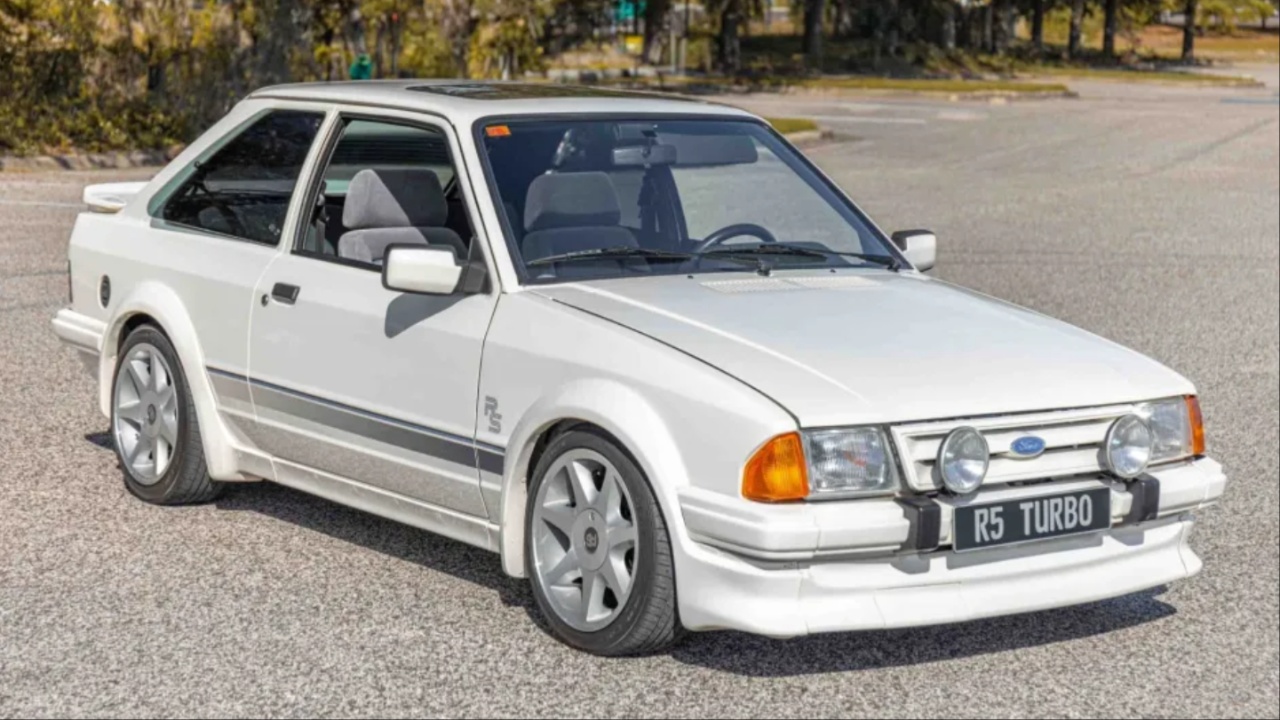
The Ford Escort RS Cosworth, an icon in rally racing, took on a new role as a safety car at the 1993 British Grand Prix. This was no ordinary Escort; it was a rally-bred monster that became a symbol of Ford’s motorsport prowess. Designed as a homologation special for the Group A rally series, it was equipped with a distinctive high-mounted whale-tail rear wing and a vertical strut that added a striking visual appeal, while also providing functional downforce. This was the first mass-produced car to feature both front and rear downforce, making it an innovative step forward in car design.
Under the hood, the Escort RS Cosworth packed a 2.0-liter turbocharged inline-4 engine, producing 224 horsepower and 224 lb-ft of torque. This gave the car the ability to accelerate from 0 to 60 mph in just 6.3 seconds, a commendable feat for a car of its era. The car was renowned for its robust performance, and its race-tuned suspension and all-wheel-drive system were tailored for rallying, allowing it to dominate rough terrains. This combination of power and precision handling made the Escort RS Cosworth a standout in motorsports.
While only 7,145 units were produced, the Escort RS Cosworth was available in various trim levels, with the base model being the most popular among motorsport enthusiasts. The base car, typically offered in plain white, was a blank canvas for modifications, allowing fans and racers to unleash its full potential on the track.
For the 1993 British Grand Prix, the Escort RS Cosworth served as a fitting tribute to Ford’s rally success. Its performance, stunning looks, and racing pedigree made it the perfect choice to lead Formula 1 cars around the track, and it remains a beloved icon in both rally and motorsport history.
The Ford Escort RS Cosworth is a legendary performance car that holds a special place in automotive history. Launched in the early 1990s, the RS Cosworth quickly gained recognition for its impressive performance and rally pedigree. This model was designed to meet the demands of both the racing world and enthusiastic drivers, blending practicality with exhilarating driving dynamics. The Escort RS Cosworth became an icon of its era, celebrated for its powerful engine, distinctive styling, and rally success.
At the heart of the Escort RS Cosworth lies a turbocharged 2.0-liter inline-four engine, derived from Ford’s collaboration with Cosworth. This potent engine delivers an impressive 227 horsepower and 228 lb-ft of torque, providing thrilling acceleration and responsiveness. With a 0 to 60 mph time of around 5.7 seconds, the RS Cosworth was a force to be reckoned with in the early 90s. The engine’s turbocharger ensures a surge of power throughout the rev range, making it an exhilarating experience for any driver.
The Escort RS Cosworth’s all-wheel-drive system was another key feature that contributed to its performance capabilities. This setup allowed for exceptional traction and stability, particularly in challenging driving conditions. The advanced all-wheel-drive system enhanced cornering ability, making the RS Cosworth a formidable competitor on both the road and the rally stage. Its handling characteristics were praised for being agile yet composed, allowing drivers to push the car to its limits with confidence.
The exterior design of the Escort RS Cosworth is unmistakable, characterized by its aggressive stance and rally-inspired features. The wide body, prominent front air intake, and oversized rear spoiler give the car a sporty and purposeful appearance. These design elements not only enhance the visual appeal but also improve aerodynamics, contributing to the car’s performance. The bold look of the RS Cosworth made it a standout on the streets and a favorite among rally fans.
Inside, the Escort RS Cosworth features a driver-focused cockpit with sporty touches. The supportive Recaro seats provide comfort and support during spirited driving, while the straightforward dashboard layout ensures that essential controls are easily accessible.
The interior combines functionality with a hint of luxury, reflecting Ford’s attention to detail in creating a performance-oriented vehicle. While primarily designed for performance, the cabin does not sacrifice comfort, making it suitable for everyday driving.
The Escort RS Cosworth was not just a road car; it also found success in rally racing. It was developed to meet Group A regulations, which required manufacturers to produce a certain number of road-going versions of their racing cars. The RS Cosworth competed in various championships, including the World Rally Championship (WRC), where it achieved significant success. Its performance on the rally stage solidified its reputation as a high-performance machine, further enhancing its desirability among enthusiasts.
Ford’s commitment to motorsport extended to the development of the RS Cosworth. The car featured advanced technologies for its time, including a sophisticated suspension system that provided excellent handling and ride comfort. The car’s braking system was also designed for performance, ensuring reliable stopping power even during intense driving scenarios. These engineering features made the RS Cosworth a well-rounded performance car, capable of tackling both the racetrack and everyday roads.
As the years progressed, the Escort RS Cosworth gained a cult following among car enthusiasts. Its combination of rally heritage, performance, and striking design made it a sought-after model for collectors and enthusiasts alike. The car’s iconic status has only grown over time, with well-maintained examples commanding impressive prices in the classic car market. The RS Cosworth represents a unique chapter in Ford’s history, symbolizing the brand’s commitment to performance and motorsport excellence.
Driving the Ford Escort RS Cosworth is a thrilling experience that evokes a sense of nostalgia for the golden age of hot hatchbacks and performance cars. The engine’s responsive nature and the all-wheel-drive system provide an exhilarating connection between driver and machine. Whether tackling twisty backroads or enjoying spirited drives, the RS Cosworth delivers an engaging and dynamic experience. The car’s character shines through in every turn, showcasing the engineering prowess behind its design.
In automotive legends, the Ford Escort RS Cosworth stands out as a symbol of performance and innovation. Its rally heritage and high-performance specifications continue to resonate with enthusiasts, ensuring its place in automotive history. The RS Cosworth’s legacy serves as a reminder of Ford’s ability to produce cars that are not only powerful but also accessible to a wider audience, bridging the gap between motorsport and everyday driving.
While the production of the Escort RS Cosworth ended in the mid-1990s, its impact on the automotive world remains significant. Many enthusiasts still cherish their ownership experiences, with clubs and communities dedicated to preserving the model’s legacy. The RS Cosworth represents a time when performance cars were raw, engaging, and built for driving enthusiasts, leaving an indelible mark on the high-performance vehicles.
The Ford Escort RS Cosworth is more than just a car; it embodies a spirit of performance, competition, and passion for driving. With its turbocharged power, all-wheel-drive capabilities, and rally-bred design, the RS Cosworth offers a unique blend of excitement and practicality.
Its legacy continues to inspire a new generation of automotive enthusiasts, reminding them of the thrill of driving and the joy of performance-oriented vehicles. The Escort RS Cosworth remains an enduring icon, celebrated by those who appreciate its engineering excellence and racing heritage, solidifying its place in the hearts of car lovers everywhere.
5) 1995 Mercedes-Benz C 36 AMG The First Formula 1 Safety Car from Mercedes
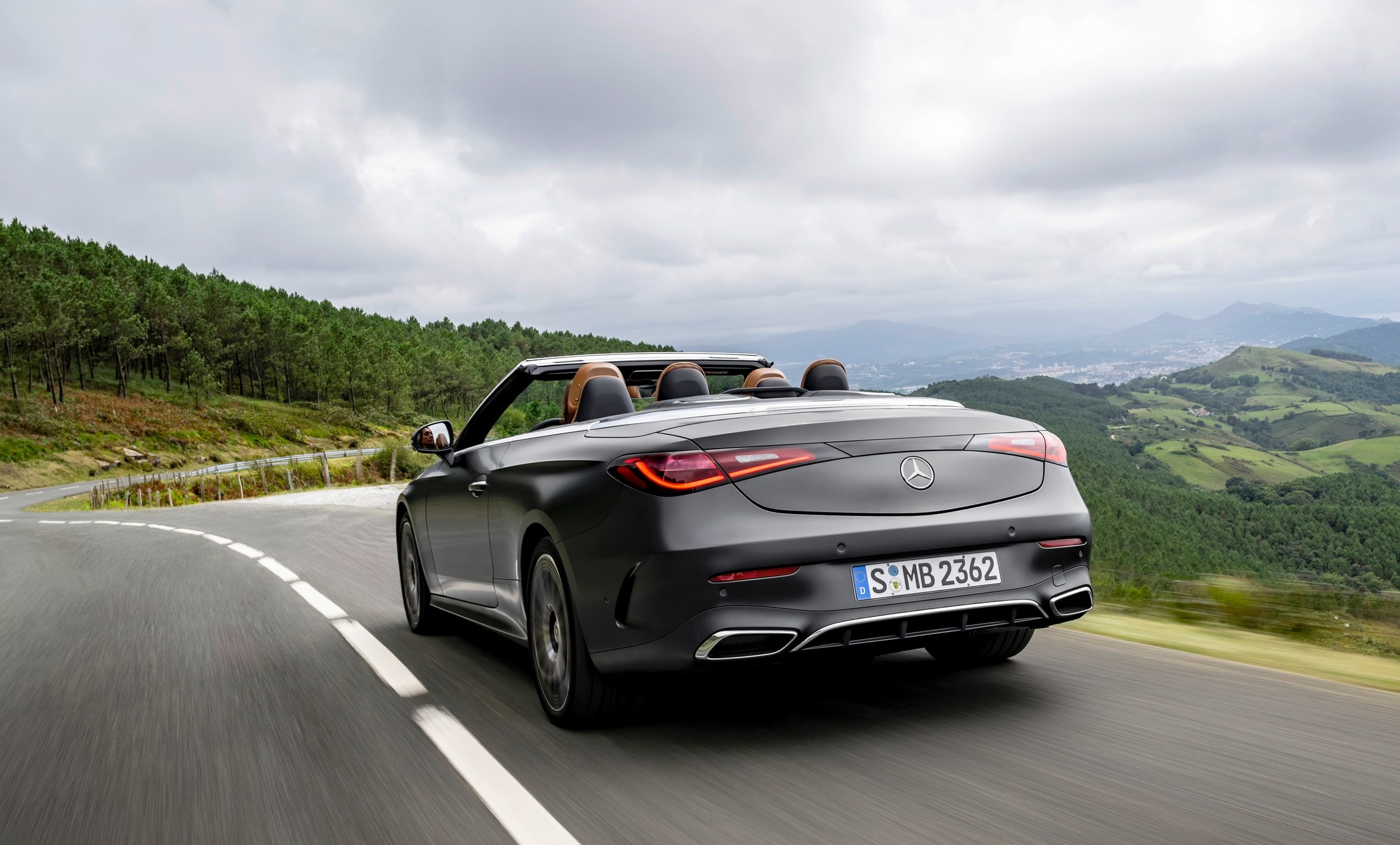
The 1995 Mercedes-Benz C 36 AMG holds a special place in the history of Formula 1, as it marked a significant milestone for the sport and for Mercedes-Benz itself. Not only was it the first C-Class to receive the prestigious AMG treatment, but it also became the first official Formula 1 safety car when Mercedes-AMG took on this vital role for the 1996 and 1997 seasons. Mercedes has since been a trusted supplier of safety cars for F1 races, and the C 36 AMG was the car that paved the way for this long-standing partnership.
Under the hood of the C 36 AMG was a 3.6-liter inline-6 engine, producing between 276 and 287 horsepower depending on the specific model. This powerful engine allowed the C 36 to maintain speed and stability, even in high-pressure situations on the race track. With a torque of 283 lb-ft at 4,000 rpm, the car could accelerate from 0 to 60 mph in just 5.8 seconds—quick enough to keep up with the Formula 1 cars and get the track cleared when necessary.
The car’s handling was further enhanced by an AMG-tuned suspension, which kept the vehicle steady and composed as it found the twists and turns of a race circuit. Although the exterior design of the C 36 was subtly modified with aerodynamic enhancements, it still retained the elegant and exclusive look that was characteristic of Mercedes-Benz at the time. The C 36 AMG was not just a high-performance sedan—it was a symbol of luxury, power, and precision.
The role of safety car in Formula 1 is a vital one, and the C 36 AMG’s debut in this position signaled the start of Mercedes’ important role in ensuring the safety of F1 drivers and officials during races. Over the years, the brand has remained a leader in providing high-performance safety cars, and the C 36 AMG remains a notable part of this legacy.
4) Lamborghini Diablo The 1990s Supercar that Stole the Spotlight in Formula 1
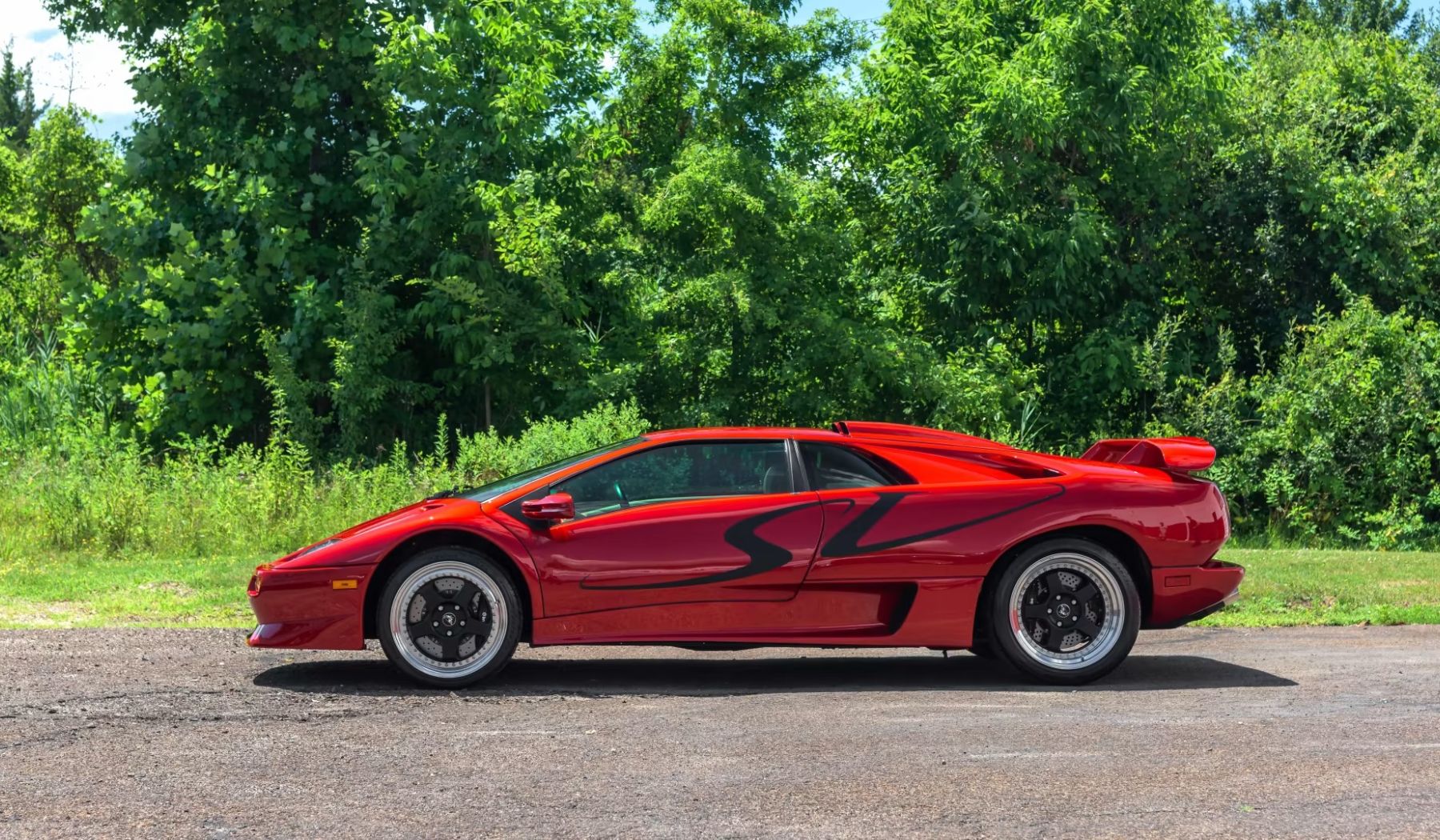
The Lamborghini Diablo, introduced in the early 1990s, perfectly encapsulated the era’s vision of speed, power, and luxury. It was the car that took the torch from the iconic Lamborghini Countach, and at the 1995 Canadian Grand Prix, it was chosen as the official safety car, adding a touch of Italian flair to the Formula 1 circuit.
At its heart, the Diablo was a masterpiece of engineering, powered by a 5.7-liter V12 engine. This engine, producing 485 horsepower and 428 lb-ft of torque, enabled the car to rocket from 0 to 60 mph in just 4.4 seconds. With a top speed of over 200 mph, it wasn’t just fast—it was lightning quick. The Diablo’s all-wheel-drive system offered superior handling, ensuring the car stayed planted to the road, even at high cornering speeds.
Aesthetically, the Lamborghini Diablo was a showstopper. Its sleek, aggressive design, combined with the luxurious blend of leather and carbon fiber, made it the epitome of 1990s supercar culture. The Diablo wasn’t just about performance; it also represented an era of excess, with advanced technology and cutting-edge design that pushed the boundaries of what a sports car could be.
As the official safety car at the 1995 Canadian Grand Prix, the Diablo added a level of excitement to the race, with its dramatic looks and powerful performance leading the F1 field. The car’s appearance on the track was a fitting tribute to Lamborghini’s legacy, and it remains an icon in the supercar world to this day.
The Lamborghini Diablo was more than just a safety car. It was a symbol of a new generation of automotive excellence—one that continues to influence high-performance cars today.
3) Mercedes-AMG GT R The Fastest Safety Car in Formula 1

The Mercedes-AMG GT R, which served as the Formula 1 Safety Car from 2018 to 2021, was a marvel of performance and precision engineering. Known for its incredible speed and handling, this car was not just a safety car—it was a true performance machine built to lead the fastest drivers in the world.
At the heart of the AMG GT R is its 4.0-liter twin-turbocharged V8 engine. This powerhouse engine produced 577 horsepower and 516 lb-ft of torque, which allowed the car to accelerate from 0 to 60 mph in just 3.2 seconds. Its top speed was nearly 200 mph, a testament to the car’s ability to keep pace with the high-performance Formula 1 race cars. Its speed was further enhanced by the absence of many of the typical limitations found in a production model, making it one of the fastest safety cars ever used in the sport.
The GT R was designed for more than just speed, though. It featured an advanced suspension system and rear-wheel steering that made it incredibly agile, allowing it to handle corners and sharp turns with ease. These features were essential in helping maintain tire temperatures for the F1 cars behind it, which is a critical aspect of keeping the race safe and efficient.
Mercedes-AMG paid attention to every detail in the design and engineering of the GT R, ensuring that it could perform at its peak when it was called upon to guide the F1 pack during a race. Its adjustable suspension and cutting-edge technology made it the ideal choice for the role, blending precision with power to perfection.
The Mercedes-AMG GT R’s time as the Formula 1 Safety Car highlighted not just its speed, but also the level of engineering excellence that Mercedes-AMG is known for. It set a new standard in safety cars, combining top-tier performance with cutting-edge safety technology.
2) 2001 Mercedes-Benz SL 55 AMG The First Supercharged Formula 1 Safety Car
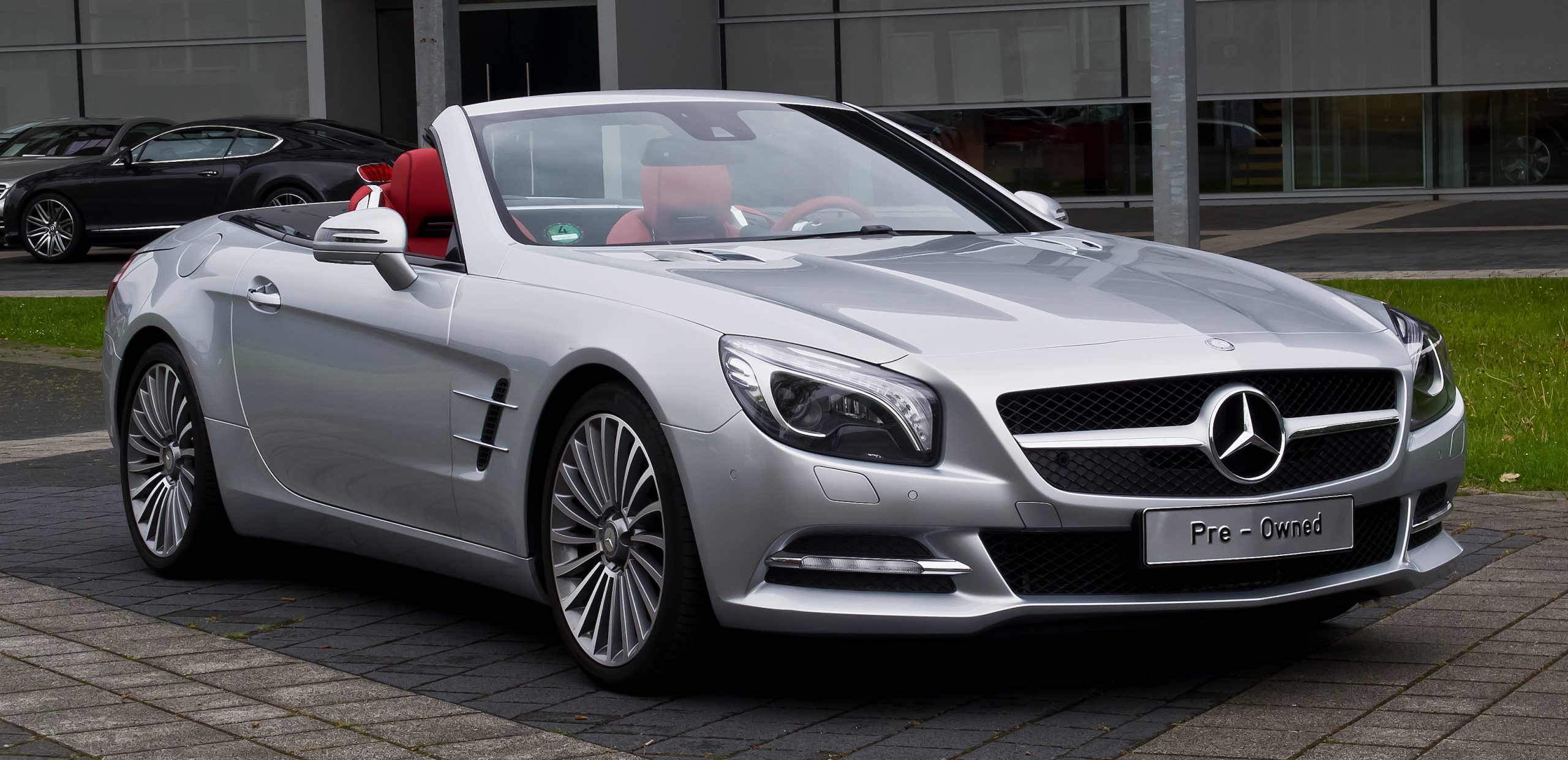
The 2001 Formula 1 season marked a new chapter for the sport’s safety car program with the introduction of the Mercedes-Benz SL 55 AMG. This was not just any safety car; it was the first supercharged safety car in Formula 1 history, and it brought both style and performance to the role. For the first time, the F1 series also hired a dedicated safety car driver, Bernd Mayländer, who has driven the safety car in nearly every race since, further cementing Mercedes’ connection to Formula 1.
The SL 55 AMG came with a powerful 5.4-liter V8 engine that was supercharged to produce an impressive 510 horsepower. This engine could propel the luxurious roadster from 0 to 60 mph in just 4.1 seconds. With 516 lb-ft of torque between 2,650 and 4,000 rpm, the SL 55 AMG had more than enough power to keep up with the fastest F1 cars when the track needed to be cleared.
Mercedes-Benz didn’t stop at just raw power. The SL 55 AMG also featured an AMG-tuned suspension and advanced braking systems that ensured it could handle the demands of the Formula 1 circuits. The combination of luxury, high-performance features, and sleek design made the SL 55 AMG a fitting choice for the F1 safety car, representing both the prestige of the SL-Class and the cutting-edge technology of Mercedes-Benz.
The SL 55 AMG’s presence on the F1 grid continued the legacy of Mercedes-Benz as the official safety car provider, a role they continue to fulfill. With its supercharged engine, striking looks, and unmatched performance, the 2001 SL 55 AMG set the standard for future safety cars in Formula 1 and became a true icon of motorsport.
1) Mercedes-Benz SLS AMG The Ultimate Formula 1 Safety Car

The Mercedes-Benz SLS AMG, introduced in 2010, is a car that not only pays homage to the legendary 300 SL Gullwing but also sets new standards for performance and design. As the Formula 1 safety car from 2010 to 2014, the SLS AMG was both a powerful symbol of Mercedes-Benz’s engineering excellence and a high-performance machine built for the racetrack.
One of the key highlights of the SLS AMG was its engine. It was powered by a 6.2-liter V8 that produced 563 horsepower, which could even go beyond 600 horsepower in certain versions, such as the Black Series. With a 7-speed automatic transmission, it could accelerate from 0 to 60 mph in just 3.6 seconds, making it one of the fastest safety cars of its era. Its top speed approached 200 mph, which was more than enough to keep up with the fast-paced Formula 1 races.
Designed from the ground up by AMG, the SLS AMG was the first Mercedes to be developed entirely by AMG. Its sleek, aerodynamic design was not just visually striking, but it also contributed to the car’s handling and stability on the track. The car’s lightweight frame and perfect balance made it an ideal choice for safely leading the F1 field during hazardous conditions. The iconic gullwing doors, a throwback to the 300 SL, added to the car’s dramatic flair, making it a favorite among fans and a symbol of style and power.
Inside, the SLS AMG was as luxurious as it was fast. The interior combined modern technology with high-end materials, offering both comfort and cutting-edge features to the driver. The car’s blend of performance and luxury made it a fitting representative of Mercedes-Benz’s commitment to innovation in motorsport.
The SLS AMG was not just a safety car; it was a true performance machine that embodied Mercedes-Benz’s rich heritage and cutting-edge technology. Its role as the Formula 1 safety car added to its legendary status, showcasing its incredible speed, handling, and timeless design.
The Mercedes-Benz SLS AMG is a remarkable supercar that encapsulates the essence of luxury, performance, and cutting-edge technology. Launched in 2010, the SLS AMG marked a significant milestone in Mercedes-Benz’s history, reviving the iconic 300SL Gullwing model while infusing it with modern engineering and performance capabilities. The SLS AMG quickly became a symbol of the brand’s commitment to high-performance vehicles, boasting a unique design and exhilarating driving experience.
One of the most striking features of the SLS AMG is its design. Inspired by the classic 300SL Gullwing, the SLS features gullwing doors that open upwards, providing not only a stunning visual but also easy access to the cabin. The car’s long hood and short rear emphasize its sporty stance, while the muscular lines and aggressive front fascia convey a sense of power and elegance. The design pays homage to its heritage while showcasing the modern aesthetic of Mercedes-Benz.
Under the hood, the SLS AMG is powered by a 6.2-liter naturally aspirated V8 engine, delivering an impressive 563 horsepower and 479 lb-ft of torque. This powerful engine allows the SLS AMG to accelerate from 0 to 60 mph in just 3.5 seconds, with a top speed of around 197 mph. The raw power of the V8 engine, combined with the car’s lightweight aluminum chassis, ensures exhilarating performance and precise handling, making it a joy to drive on both the road and the track.
The SLS AMG features a rear-wheel-drive layout and a seven-speed dual-clutch automatic transmission (DCT) that provides quick and seamless shifts. This setup enhances the car’s responsiveness and agility, allowing drivers to experience the full capabilities of the powerful V8 engine. The AMG-tuned suspension system further enhances handling, ensuring that the car remains planted during high-speed maneuvers and provides exceptional feedback to the driver.
Inside, the SLS AMG offers a blend of luxury and sportiness, with high-quality materials and a driver-focused layout. The cabin is adorned with premium leather, carbon fiber accents, and aluminum trim, creating an upscale atmosphere. The supportive sport seats provide excellent comfort during spirited drives, while the intuitive infotainment system offers modern connectivity features. The focus on driver engagement is evident in the layout, with all controls positioned for easy access.
The SLS AMG also incorporates advanced technology to enhance both performance and safety. Features such as adaptive cruise control, a rearview camera, and stability control systems contribute to a more enjoyable driving experience. The integration of modern technology complements the car’s performance, ensuring that drivers can enjoy both power and convenience.
In terms of performance, the SLS AMG is built for the racetrack, with various performance-oriented options available. The AMG Performance Package, for instance, includes features such as a more aggressive exhaust system and enhanced aerodynamics, further amplifying the driving experience. The car’s braking system is equally impressive, featuring large disc brakes that provide exceptional stopping power, ensuring confidence even at high speeds.
The SLS AMG has made a significant impact in the automotive world, earning accolades for its performance, design, and engineering excellence. It has been featured in numerous automotive publications and events, further cementing its status as a modern classic. Its blend of performance and luxury has attracted enthusiasts and collectors alike, making it a sought-after model in the supercar segment.
The SLS AMG is not just about performance; it also offers a level of practicality uncommon in supercars. The trunk space is relatively generous, allowing for some everyday usability. This combination of performance and practicality sets the SLS AMG apart, making it a versatile option for those who want a supercar they can drive daily.
In 2012, the SLS AMG GT was introduced as an enhanced version of the original model, featuring a more powerful engine with 583 horsepower and improved handling characteristics. This version further refined the driving experience, solidifying the SLS AMG’s position as a top contender in the supercar market. The GT variant showcased AMG’s commitment to continuous improvement and innovation, ensuring that the SLS remained competitive against newer rivals.
The SLS AMG’s motorsport pedigree is evident in its participation in various racing events, including the GT3 series. The car’s racing success has helped to hone its performance characteristics, with lessons learned on the track translating into enhancements for the road version. This connection to motorsport adds another layer of excitement for enthusiasts, knowing that they are driving a car with a rich racing heritage.
After its production ended in 2014, the SLS AMG left a lasting legacy within the automotive community. Its distinctive design, exhilarating performance, and luxurious features have made it a timeless classic that continues to attract attention. Collectors value well-maintained SLS AMGs, with prices appreciating over time, reflecting the car’s status as a modern automotive icon.
Driving the Mercedes-Benz SLS AMG is an experience like no other. The roar of the V8 engine, coupled with the dramatic gullwing doors, creates a sense of occasion every time you get behind the wheel. The direct connection between the driver and the car enhances the thrill of driving, making it a true performance machine. Every twist and turn on the road brings out the car’s dynamic handling, ensuring that the driver remains engaged and exhilarated.
The Mercedes-Benz SLS AMG is a celebration of performance, design, and engineering excellence. It successfully combines the classic appeal of the 300SL Gullwing with modern technology, creating a supercar that delivers on every front. Its status as a high-performance luxury vehicle ensures its place in automotive history, appealing to enthusiasts who appreciate both power and elegance.
The SLS AMG’s legacy will undoubtedly continue to influence future generations of supercars, solidifying its position as one of the defining models of its era. Whether on the road or the racetrack, the SLS AMG embodies the spirit of performance that Mercedes-Benz represents, making it a true masterpiece in luxury automobiles.

